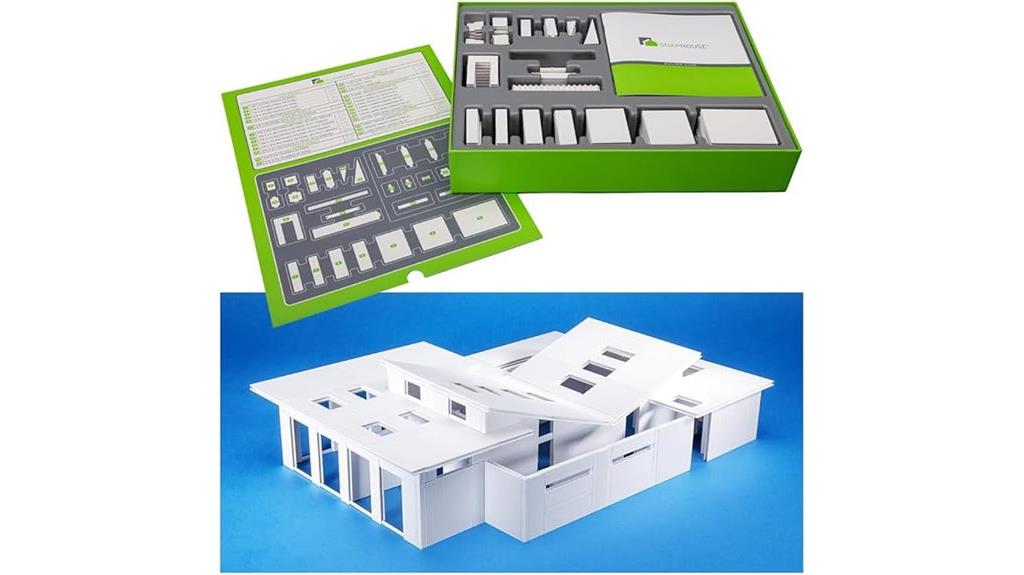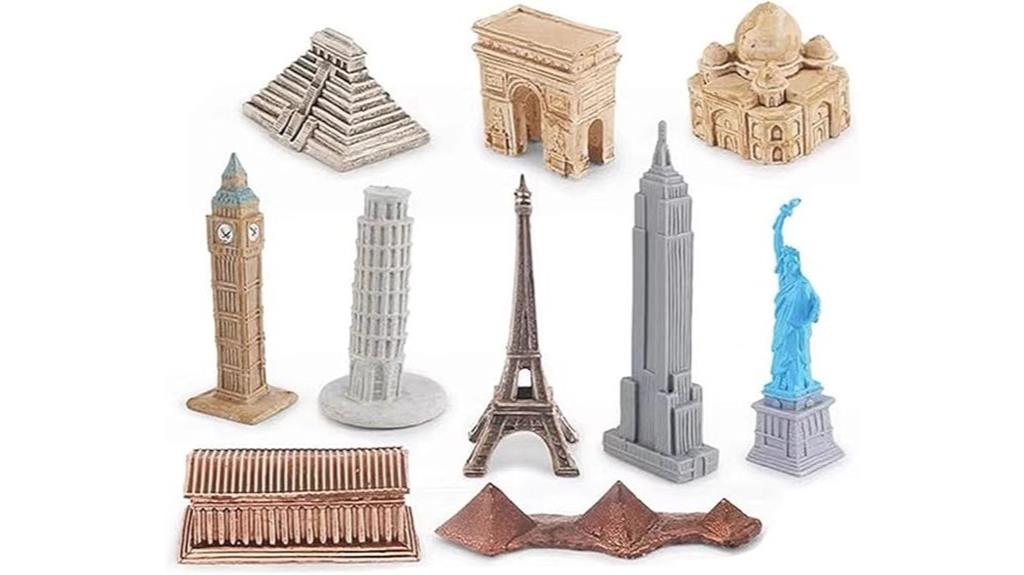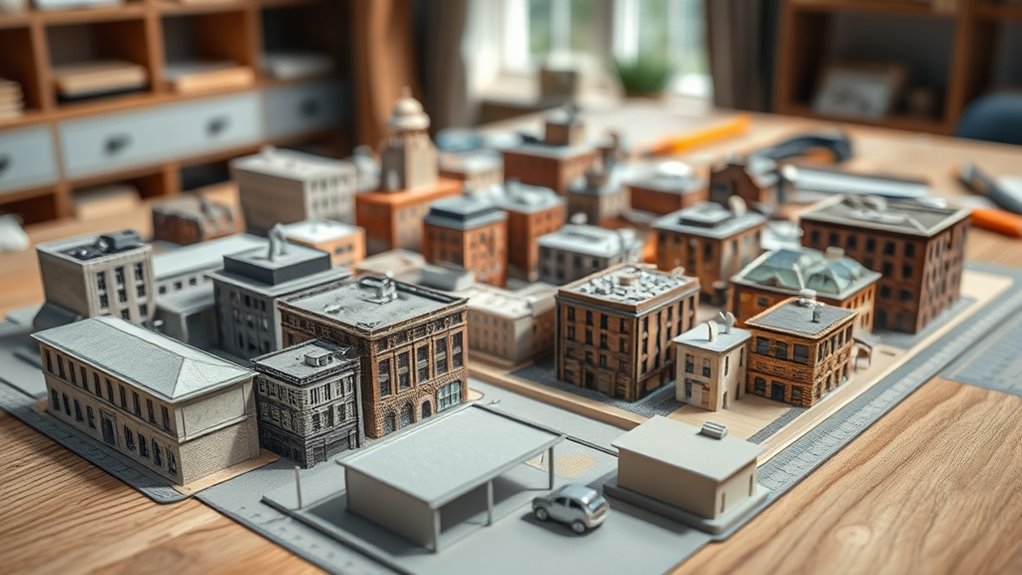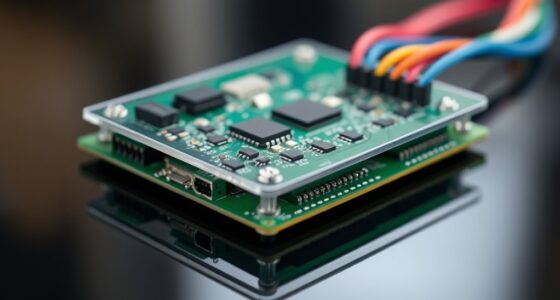For aspiring designers in 2025, I recommend the SnapHouse Architectural Scale Model Building Kit and the Mini World Architectural Model Set. The SnapHouse kit offers versatile pieces and supports detailed, scalable projects ideal for building skills. The Mini World set provides compact, realistic models great for display and quick experimentation. Both kits focus on reusability, ease of assembly, and educational value. Keep exploring to discover how these options can boost your creative journey.
Key Takeaways
- Choose kits with versatile, reusable components to foster ongoing creativity and experimentation.
- Prioritize models that balance detailed features with manageable size for practical display and learning.
- Select options suitable for beginners, offering clear instructions and user-friendly assembly.
- Opt for durable, flexible materials to ensure longevity and support diverse architectural styles.
- Consider educational value, such as promoting spatial reasoning and understanding of architectural principles.
SnapHouse Architectural Scale Model Building Kit (452 Piece)

The SnapHouse Architectural Scale Model Building Kit (452 Pieces) is perfect for aspiring designers of all skill levels who want to bring their architectural ideas to life. With 28 unique shapes and 452 parts, it allows you to create detailed models of houses up to 2,500 sq ft at a 1:48 scale. No special skills or extra tools are needed, making it accessible for beginners and seasoned modelers alike. All parts are reusable, so you can build, dismantle, and rebuild as often as you like. It’s a flexible kit that supports a wide range of architectural styles, encouraging creativity and experimentation.
Best For: hobbyists, students, and aspiring architects of all skill levels looking to design and build detailed, customizable architectural models.
Pros:
- User-friendly with no special skills or tools required, suitable for beginners and experienced modelers alike
- Reusable parts offer extensive design flexibility and allow for multiple rebuilds and experimentation
- Supports a wide range of architectural styles, encouraging creativity and personalized projects
Cons:
- Limited to house models up to 2,500 sq ft at 1:48 scale unless additional parts are purchased
- May require purchasing extra parts for larger or more complex projects
- Not designed for highly detailed or large-scale architectural models beyond the specified size
Mini World Architectural Model Set

If you’re interested in sparking creativity and expanding your knowledge of architectural styles, the Mini World Architectural Model Set is an excellent choice. It includes ten detailed plastic models representing different architectural styles, ranging from 1.97 to 3.9 inches tall. Each piece is expertly hand-painted, offering a realistic and visually appealing look that captures attention. Suitable for ages 6 and up, this set encourages imaginative play, recognition of historic monuments, and world-building. Its compact size makes it perfect for display or decoration, whether on a desk or as part of a collection. I find it a versatile, educational, and fun addition for aspiring designers.
Best For: educators, architecture enthusiasts, and children aged 6 and above who want to explore, learn, and creatively engage with architectural designs and historic monuments.
Pros:
- Highly detailed and realistic models that enhance visual appeal and encourage imaginative play
- Compact and lightweight, ideal for display, collection, or decoration on desks or shelves
- Educational tool that promotes recognition of architectural styles and historic landmarks
Cons:
- Made of plastic, which may lack the durability of more robust materials for rough handling
- Limited size range (1.97 to 3.9 inches), potentially restricting detailed study of larger structures
- Suitable primarily for ages 6 and up; may be less engaging for older collectors or professionals
Factors to Consider When Choosing The Architectural Model Kits for Aspiring Designers

When selecting an architectural model kit, I consider factors like skill level compatibility and the variety of size options to match my experience and project needs. I also look at the material quality to guarantee durability and flexibility for different design ideas, along with the range of architectural styles offered. These points help me choose a kit that best supports my growth and creativity as a designer.
Skill Level Compatibility
Choosing an architectural model kit that matches your skill level is essential for a smooth learning experience. Whether you’re a beginner, intermediate, or advanced builder, selecting the right kit guarantees you stay motivated and avoid frustration. Beginner kits usually feature simplified parts and fewer components, making assembly easier and more enjoyable. If you’re more experienced, advanced kits offer complex shapes and higher piece counts, allowing for detailed, realistic models. Also, check if the kit includes clear instructions and guidance, which can be invaluable at any skill level. Matching your skill level helps prevent discouragement, ensures steady progress, and keeps the modeling process fun. Picking the right kit tailored to your abilities creates a solid foundation for developing your architectural modeling skills.
Model Size Options
Model size options play a crucial role in shaping the overall design process and presentation. Smaller models are portable, easy to handle, and ideal for quick, focused presentations or limited spaces. They allow for faster assembly and are perfect for capturing key details without overwhelming the viewer. Larger models offer more room for intricate architectural features, providing a realistic and detailed view of the design. However, they require more space and materials, which can increase costs and setup time. When choosing size, consider the model’s purpose—whether it’s for detailed client presentations or quick internal reviews—and the available display area. Balancing detail, portability, and practicality ensures you select a model size that best supports your design goals and presentation needs.
Material Quality and Durability
The materials used in architectural model kits directly affect how well your models hold up over time and how easy they are to handle. High-quality options like sturdy plastics or wood ensure your models are durable enough for frequent handling and assembly. Using resilient materials reduces the risk of breakage or damage, helping your project stay intact longer. Additionally, the choice of materials influences the model’s weight and portability, making it easier to transport and display. Reusable components crafted from durable materials allow for multiple rebuilds, encouraging experimentation and refinement. Plus, better materials enable finer detail and more precise finishes, elevating the realism and accuracy of your models. Prioritizing quality materials ultimately leads to more reliable, detailed, and long-lasting architectural models.
Design Flexibility
When selecting architectural model kits, it’s essential to take into account their design flexibility, as this determines how creatively and accurately you can bring your ideas to life. A versatile kit offers a variety of shapes and parts, allowing for diverse building options that match your vision. Reusable components and adjustable elements let you modify and refine your models repeatedly, fostering experimentation. Kits with multiple orientation choices for each piece support complex, innovative designs, pushing your creative boundaries. Additionally, expandability or extra parts can greatly broaden your design possibilities. Flexibility also means the kit can accommodate different architectural styles, from traditional to ultra-modern. This adaptability encourages experimentation and personal expression, making it an important factor in choosing the right model kit for aspiring designers.
Architectural Style Range
Choosing an architectural model kit with a wide range of styles opens up countless possibilities for creative exploration. When a kit includes traditional, modern, and even futuristic designs, I can experiment with different architectural concepts and learn how various stylistic elements come together. A thorough kit provides multiple shapes and components, making it easier to build models across diverse genres. Exposure to a variety of styles not only broadens my understanding of architectural features but also helps develop a versatile skill set. As I explore different aesthetics, I can better grasp what makes each style unique and how to incorporate those elements into my own designs. Ultimately, selecting a kit with an extensive style range encourages innovation and helps build a well-rounded portfolio.
Ease of Assembly
Selecting an architectural model kit that’s easy to assemble can make a big difference, especially if you’re just starting out. Look for kits with clear, step-by-step instructions that guide you through each stage, reducing confusion. Pre-cut or pre-shaped pieces also simplify assembly and save time, making the process smoother. Pay attention to the number of small or intricate parts; fewer of these mean less frustration and quicker progress. Reusable components are a bonus—they allow you to experiment and adjust without starting from scratch. Additionally, consider if the kit includes tools or accessories, like snap-fit parts or easy-to-handle materials, which can further streamline the building process. Ultimately, an accessible kit helps maintain motivation and boosts confidence as you develop your skills.
Reusability Potential
Reusability is a key factor that can considerably extend the value of an architectural model kit. When a kit features versatile components that can be rearranged or repurposed, it allows me to explore multiple design ideas without needing new materials. High reusability conserves both time and money, making it ideal for long-term experimentation. Reusable parts also encourage creative exploration, as I can dismantle and rebuild models to test different styles and configurations. The durability and flexibility of the materials directly influence how well the kit holds up over multiple projects. A well-designed, high-quality kit ensures that components remain intact and functional after repeated use, providing a cost-effective, sustainable way to develop architectural skills and ideas over time.
Educational Value
The educational value of architectural model kits plays an essential role in developing key skills for aspiring designers. These kits promote spatial reasoning and deepen understanding of architectural principles through hands-on construction. They serve as visual tools that help users learn about different styles, structural elements, and design concepts, making complex ideas more accessible. Building models also enhances fine motor skills and attention to detail, which are vital for future architects. Additionally, model kits can be effective teaching aids in classrooms, illustrating scale, proportion, and construction techniques clearly. Engaging with these kits fosters creativity and critical thinking, encouraging experimentation with innovative designs. Overall, their educational benefits support skill development and inspire confidence in aspiring designers.
Frequently Asked Questions
What Skills Are Essential for Beginners in Architectural Modeling?
To get started in architectural modeling, I think you need patience, attention to detail, and creativity. You should be comfortable working with various materials like paper, plastic, or foam. Basic skills in measuring accurately and understanding scale are vital. Also, having a good sense of spatial awareness helps bring your designs to life. Practice regularly and learn from tutorials or experienced modelers to improve your skills steadily.
How Do Digital Tools Complement Physical Model Kits?
Digital tools turn architectural modeling from a dusty hobby into a high-tech adventure. I love how software allows me to tweak designs instantly, visualize in 3D, and catch mistakes before breaking out the glue. They’re the perfect sidekick to physical kits, making the process faster, more precise, and way more fun. Who knew that combining digital magic with tangible models would make aspiring designers feel like modern-day architects?
What Is the Ideal Age Range for These Model Kits?
I believe the ideal age range for architectural model kits is between 10 and 18 years old. Younger kids might find them too complex, while older teens and adults can fully enjoy the challenge and creativity involved. I recommend starting with simpler kits for beginners, then progressing to more detailed ones as skills develop. These kits are perfect for inspiring young designers and fostering a love for architecture early on.
Can These Kits Be Customized or Expanded Over Time?
I love how many of these kits are designed to be customizable or expandable. You can start with a basic set and add new pieces or features over time, which keeps the project exciting and engaging. It’s a great way to develop your skills gradually and create more complex, detailed models. Plus, expanding your kit allows for endless creativity, making each project uniquely yours and evolving with your growing interest in architecture.
Are There Environmentally Friendly or Sustainable Model Kit Options?
Certainly, there are thoughtfully designed, eco-conscious model kits that align with sustainability ideals. I’ve discovered options made from recycled materials, biodegradable components, and eco-friendly adhesives, which not only reduce environmental impact but also inspire responsible creativity. Exploring these environmentally mindful kits allows you to indulge in architectural modeling while subtly supporting greener practices, making your passion for design both innovative and kind to our planet.
Conclusion
Choosing the right architectural model kit is like picking a compass for your creative journey. Whether you’re just starting out or looking to refine your skills, the perfect kit will guide you through the landscape of design with confidence and excitement. Remember, it’s not just about building models; it’s about shaping your future as a designer. So, pick the kit that sparks your passion, and let your imagination be the map that leads you onward.









